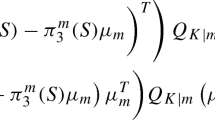Abstract
We consider the problem of classifying a p× 1 observation into one of two multivariate normal populations when the training samples contain a block of missing observations. A new classification procedure is proposed which is a linear combination of two discriminant functions, one based on the complete samples and the other on the incomplete samples. The new discriminant function is easy to use. We consider the estimation of error rate of the linear combination classification procedure by using the leave-one-out estimation and bootstrap estimation. A Monte Carlo study is conducted to evaluate the error rate and the estimation of it. A numerical example is given tof illustrate its use.
Similar content being viewed by others

References
Anderson, T. W. (1951). Classification by multivariate analysis, Psychometrika, 16, 31–50.
Anderson, T. W. (1957). Maximum likelihood estimates for a multivariate normal distribution when some observations are missing, J. Amer. Statist. Assoc, 52, 200–203.
Bohannon, Tom R. and Smith, W. B. (1975). Classification based on incomplete data records ASA Proc. Social Statistics Section, 214–218.
Chan, L. S. and Dunn, O. J. (1972). The treatment of missing values in discriminant analysis-1, The sampling experiment, J. Amer. Statist. Assoc., 67, 473–477.
Chan, L. S. and Dunn, O. J. (1974). A note on the asymptotical aspect of the treatment of missing values in discriminant analysis, J. Amer. Statist. Assoc., 69, 672–673.
Dempster, A. P., Laird, N. M. and Rubin, R. J. A. (1977), Maximum likelihood from incomplete data via the EM algorithm, J. Roy. Statist. Soc. Ser. B, 39, 1–38.
Hocking, R. R. and Smith, W. B. (1968). Estimation of parameters in the mutivariate normal distribution with missing observation, J. Amer. Statist. Assoc., 63, 159–173.
McLachlan, G. J. (1974). An asymptotic unbiased technique for estimating the error rates in discriminant analysis, Biometrics, 30, 239–249.
McLachlan, G. J. (1980). The efficiency of Efron's bootstrap approach applied to error rate estimation in discriminant analysis, J. Statist. Comput. Simulation, 11, 273–279.
Okamoto, Masashi (1963), An asymptotic expansion for the distribution of the linear discriminant function, Ann. Math. Statist., 34, 1286–1301.
Twedt, Daniel J. and Gill, D. S. (1992), Comparison of algorithm for replacing missing data in discriminant analysis, Comm. Statist. Theory Methods, 21, 1567–1578.
Wald, A. (1944). On a statistical problem arising in the classification of an individual into one of two groups, Ann. Math. Statist., 15, 145–162.
Author information
Authors and Affiliations
About this article
Cite this article
Chung, HC., Han, CP. Discriminant Analysis When a Block of Observations is Missing. Annals of the Institute of Statistical Mathematics 52, 544–556 (2000). https://doi.org/10.1023/A:1004129706000
Issue Date:
DOI: https://doi.org/10.1023/A:1004129706000



